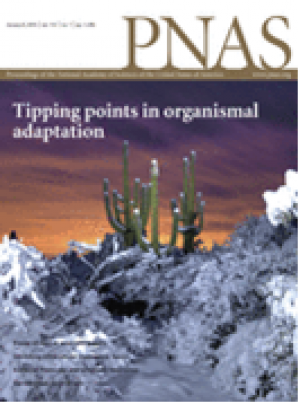|
Ubiquitin-specific protease UBP14 stabilizes HY5 by deubiquitination to promote photomorphogenesis in Arabidopsis thaliana
Friday, 2024/08/16 | 08:17:21
|
|
Ke Fang, Xiuhong Yao, Yu’ang Tian, Yang He, Yingru Lin, Wei Lei, Sihan Peng, Guohui Pan, Haoyu Shi, Dawei Zhang, and Honghui Lin PNAS August 5, 2024; 121 (33) e2404883121 SignificanceFor the initial growth of seedlings, the transcription factor ELONGATED HYPOCOTYL5 (HY5) plays a critical role by initiating a series of light responses. Here, we demonstrated that besides transcription activity of HY5, the HY5 protein level, which is stringently regulated by deubiquitinating enzymes, is also vital for photomorphogenesis. We identified a ubiquitin-specific protease, Ub-SPECIFIC PROTEASE 14 (UBP14), which positively promotes plant photomorphogenesis in response to light. UBP14 directly interacts with HY5 and protects it from degradation by 26S proteasomes. Besides, HY5 promotes the expression and protein accumulation of UBP14 for positive feedback. The dynamic regulatory mechanism for UBP14 and HY5 provides an insight into the roles of posttranslational modifications of HY5 during photomorphogenesis in Arabidopsis thaliana. AbstractTranscription factor ELONGATED HYPOCOTYL5 (HY5) is the central hub for seedling photomorphogenesis. E3 ubiquitin (Ub) ligase CONSTITUTIVE PHOTOMORPHOGENIC 1 (COP1) inhibits HY5 protein accumulation through ubiquitination. However, the process of HY5 deubiquitination, which antagonizes E3 ligase-mediated ubiquitination to maintain HY5 homeostasis has never been studied. Here, we identified that Arabidopsis thaliana deubiquitinating enzyme, Ub-SPECIFIC PROTEASE 14 (UBP14) physically interacts with HY5 and enhances its protein stability by deubiquitination. The da3-1 mutant lacking UBP14 function exhibited a long hypocotyl phenotype, and UBP14 deficiency led to the failure of rapid accumulation of HY5 during dark to light. In addition, UBP14 preferred to stabilize nonphosphorylated form of HY5 which is more readily bound to downstream target genes. HY5 promoted the expression and protein accumulation of UBP14 for positive feedback to facilitate photomorphogenesis. Our findings thus established a mechanism by which UBP14 stabilizes HY5 protein by deubiquitination to promote photomorphogenesis in A. thaliana.
See https://www.pnas.org/doi/10.1073/pnas.2404883121
Figure 1: UBP14 interacts with HY5 in vitro and in vivo. (A) Interaction between UBP14 and HY5 in Y2H assays. 3-AT (20 mM) was used to inhibit self-activation activity. (B) In vitro pull-down assays of UBP14 and HY5. Anti-MBP and anti-His antibodies were used to detect MBP-HY5 and His-UBP14, respectively. (C) BiFC assays showing UBP14 interacts with HY5 in N. benthamiana. (Scale bar, 50 μm.) A transformation control (35S: RFP) was coinfiltrated with the BiFC constructs and served as a marker for successful transfection. (D) Co-IP assays showing the interaction between UBP14 and HY5. The hypocotyls of LD-grown 6-d-old proUBP14: HA-FLAG-UBP14 proHY5: GFP, proUBP14: HA-FLAG-UBP14 proHY5: HY5-GFP seedlings after dark-to-light transition for 4 h were sampled for experiments. HA-specific antibody–conjugated agarose beads were used for immunoprecipitation. The input and the immunoprecipitation products were detected by anti-GFP and anti-HA antibodies.
|
|
|
|
[ Other News ]___________________________________________________
|


 Curently online :
Curently online :
 Total visitors :
Total visitors :
(143).png)



















